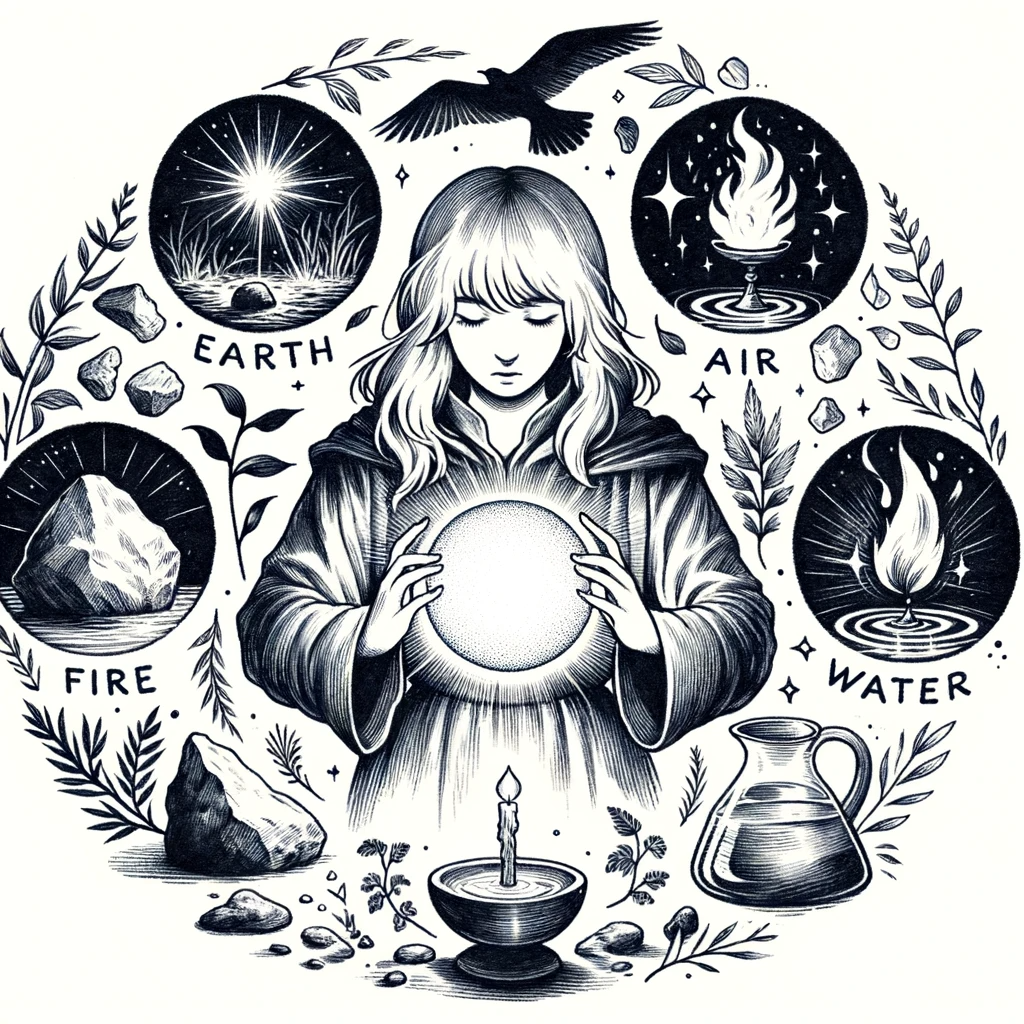Astrology offers a unique lens through which we view our lives, providing guidance and insights through the alignment of the stars and planets. Each week, we compile horoscopes for the twelve zodiac signs, offering advice and predictions that touch on various aspects of life from personal growth to professional opportunities.
Understanding the process behind these predictions not only enriches the reading experience but also deepens the appreciation of this ancient art. Now, each astrologer may have a slightly different approach and method, but this is a peek behind the scenes of how it’s done at honeymallow!
Astrological Foundations
Astrology rests on the foundational belief that celestial movements influence terrestrial life. The zodiac, a celestial coordinate system that divides the sky into twelve signs, is central to this practice. Each sign represents different energy patterns and personality traits, which are influenced by planetary movements.
The Zodiac Wheel
The zodiac wheel is more than just a circle of star signs; it is a dynamic framework that captures the essence of human experiences and traits distributed among fire, earth, air, and water elements. Each sign is also categorized into cardinal, fixed, and mutable modes, which describe the basic approach of the signs towards life: initiating, sustaining, and changing.
Planetary Roles and Movements
Planets are the active forces in astrology, each adding a layer of meaning to the zodiac signs they visit. From the fast-moving Moon and Mercury to slow-moving Neptune and Pluto, each planet’s transit brings to light different facets of our lives. This week-to-week movement is critical in shaping the themes of the horoscopes.
The Importance of the Moon
In the weekly astrological forecast, the Moon’s phase and position are especially significant. The Moon travels quickly through the zodiac, spending about two and a half days in each sign, reflecting our fleeting emotions and changing moods that color the weekly outlook.
Constructing the Weekly Horoscope
Creating a weekly horoscope involves synthesizing the current planetary arrangements into a coherent narrative that resonates with each zodiac sign. This process is both an art and a science, requiring a deep understanding of astrology’s symbolic language.
Planetary Transits
We look at the interactions between the moving planets and the static positions of planets at one’s birth, known as transits. These transits highlight which areas of a person’s life might be activated or challenged during the week, depending on which house and sign they fall into.
- Sun’s Transit: The Sun changes signs approximately once a month. Its position can highlight which areas of life are most illuminated for each sign.
- Moon’s Phases and Transits: The Moon changes signs every 2.5 days and goes through all zodiac signs in about 28 days. Its phases (new, waxing, full, waning) significantly affect emotional and intuitive energy.
- Mercury, Venus, and Mars: These faster-moving planets affect everyday life in terms of communication, relationships, and energy, respectively.
- Jupiter, Saturn, Uranus, Neptune, Pluto: The slower-moving planets shape longer-term trends in personal growth, challenges, changes, dreams, and transformations.
Sign-Specific Focus
While personal horoscopes are tailored to an individual’s birth chart, our weekly horoscopes are generalized for each sign. We focus on how planetary transits interact with the sun sign of each person, delivering guidance that is meant to resonate with broader audiences.
Major Aspects and Configurations and Other Events
We also consider the aspects, or angles, planets make with each other during the week. These aspects, such as trines (120 degrees), squares (90 degrees), and oppositions (180 degrees), inform the tone and theme of the horoscope. A square might indicate a week of challenges, while a trine could suggest a smooth, harmonious period.
- Conjunctions (planets in the same sign) amplify energies.
- Squares (90 degrees apart) suggest challenges or tensions.
- Trines (120 degrees apart) and sextiles (60 degrees apart) bring ease and opportunities.
- Oppositions (180 degrees apart) highlight areas of life requiring balance.
It’s also important to reflect on how eclipses might catalyze significant changes and focus on what is being eclipsed in or out of life. Additionally, retrogrades, particularly of Mercury, Venus, and Mars, often signify times of reevaluation in their respective domains (thinking and communication, love and values, action and aggression).
The Art of Interpretation
Interpreting the complex data collected from the celestial sphere requires not only technical skill but also an intuitive understanding of human psychology and symbolic language.
Synthesizing Cosmic Information
We use our knowledge of astrological symbolism to blend the various elements—planetary positions, zodiac sign qualities, and house meanings—into a coherent and meaningful guide for each sign. This synthesis involves balancing different energies to provide a nuanced reading that reflects the upcoming week’s astrological climate.
Mitigating Contradictory Signals
Often, the stars offer mixed signals, with some aspects suggesting action while others advise caution. We navigate these contradictions through prioritization and emphasis, highlighting the most dominant astrological influences for the week and offering a balanced perspective that is informative yet approachable.
Predictive Techniques
Besides transits, we employ predictive techniques like using planetary hours for daily timing, monitoring eclipse cycles, and noting periods of retrograde motion. These techniques help refine the predictions made, ensuring they are both timely and pertinent.
Weekly Themes and Their Significance
Each week, we craft horoscope readings that not only forecast the future but also dissect complex astrological configurations to pull out thematic strands relevant to all twelve signs. This segment explores how weekly themes are developed and their relevance to everyday life.
Common Themes Explored
Our astrological readings typically touch on several universal themes: love and relationships, career and work challenges, personal growth opportunities, and potential obstacles. These themes are chosen based on planetary alignments; for example, Venus’ transit might highlight matters of the heart, while Mercury’s position could focus on communication issues.
Influence of Lunar Cycles
The lunar cycle plays a crucial role in shaping the astrological week. The new moon, full moon, and the quarters each hold specific astrological significance. For instance, new moons are ideal for beginnings and launches, full moons are for culmination and realization, and quarter moons are points of adjustment.
Relevance to Daily Life
The alignment of the planets offers insights into the collective rhythm of human life. We interpret these alignments to provide guidance that helps individuals align their actions with the cosmic flow. This makes astrology a practical tool for personal and professional planning.
Crafting the Narrative
Writing weekly horoscopes is about more than just predicting events; it’s about crafting a narrative that engages and resonates. We must translate complex astrological concepts into accessible advice that captivates and motivates readers.
Language and Expression
The language used in our horoscopes must be clear, evocative, and empowering. We choose words that foster an inclusive and supportive environment, encouraging readers to explore their potential while remaining mindful of astrological challenges. Precision in language helps demystify astrology, making it accessible to new and seasoned readers alike.
Balancing Clarity and Complexity
We face the challenge of making detailed astrological analysis understandable without oversimplifying the profound insights astrology offers. This balance is crucial in ensuring that readers feel informed and enlightened rather than confused or patronized.
Engagement Techniques
To keep the narrative engaging, we often employ storytelling techniques, weaving the week’s planetary configurations into a cohesive story that highlights growth, reflection, and foresight. This approach not only enhances readability but also helps readers see the practical implications of the astrological events in their own lives.
Ethical and Practical Considerations
Astrology is a tool for insight and guidance, and with it comes a responsibility to uphold ethical standards while ensuring practical relevance.
Maintaining Objectivity
It is essential for us to remain objective and unbiased. Our interpretations should be grounded in astrological theory and practice, avoiding personal biases that could skew the advice given. This objectivity ensures that the horoscopes serve the needs of a diverse audience.
Cultural and Universal Relevance
Our horoscopes should be culturally sensitive and universally applicable. We ensure that our readings do not favor any particular cultural perspective but rather speak to common human experiences and challenges, making the guidance relevant across different backgrounds and lifestyles.
The Responsibility of Timeliness
Accuracy in timing is paramount in astrology. We must ensure that our readings reflect the exact movements and positions of celestial bodies to provide timely and relevant advice. This precision helps in maintaining the credibility and reliability of astrological forecasts.
The process of crafting weekly horoscope readings is intricate and layered. It combines astrological science with intuitive artistry to create narratives that guide, inspire, and enlighten. We try to balance cosmic complexity with narrative clarity to bring valuable insights that resonate with everyday life, helping individuals navigate their week with confidence and clarity.
















